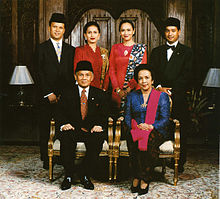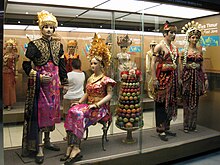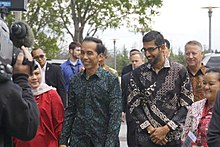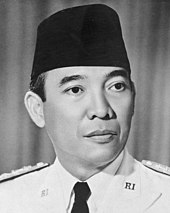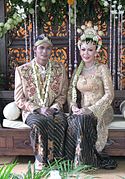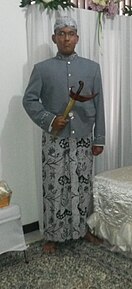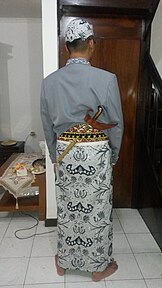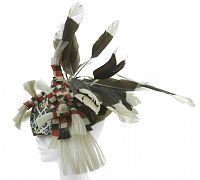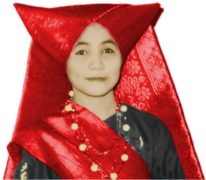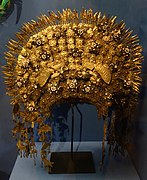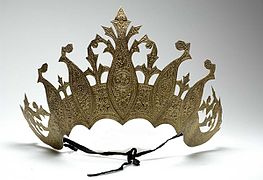
Batik is an Indonesian technique of wax-resist dyeing applied to the whole cloth. This technique originated from the island of Java, Indonesia. Batik is made either by drawing dots and lines of wax with a spouted tool called a canting, or by printing the wax with a copper stamp called a cap. The applied wax resists dyes and therefore allows the artisan to colour selectively by soaking the cloth in one colour, removing the wax with boiling water, and repeating if multiple colours are desired.

A folk costume expresses a national identity through clothing or costume, which is usually associated with a specific region or period of time in history. It can also indicate social, marital, or religious status. If the costume is used to represent the culture or identity of a specific ethnic group, it is usually known as ethnic costume. Such costumes often come in two forms: one for everyday occasions, the other for traditional festivals and formal wear. The word "costume" in this context is sometimes considered pejorative due to the multiple senses of the word, and in such cases "clothing", "garments" or "regalia" can be substituted without offense.
Ikat is a dyeing technique from Indonesia used to pattern textiles that employs resist dyeing on the yarns prior to dyeing and weaving the fabric. The term is also used to refer to related and unrelated traditions in other cultures. In Southeast Asia, where it is the most widespread, ikat weaving traditions can be divided into two general clades. The first is found among Daic-speaking peoples. The second, larger group is found among the Austronesian peoples and spread via the Austronesian expansion. Similar dyeing and weaving techniques that developed independently are also present in other regions of the world, including India, Central Asia, Japan, Africa, and the Americas.

A sarong or a sarung is a large tube or length of fabric, often wrapped around the waist, worn in Southeast Asia, South Asia, Western Asia, Northern Africa, East Africa, West Africa, and on many Pacific islands. The fabric often employs woven plaid or checkered patterns or may be brightly colored by means of batik or ikat dyeing. Many modern sarongs have printed designs, often depicting animals or plants. Different types of sarongs are worn in different places in the world, notably the lungi in the Indian subcontinent and the izaar in the Arabian Peninsula.

The culture of Indonesia has been shaped by long interaction between original indigenous customs and multiple foreign influences. Indonesia is centrally-located along ancient trading routes between the Far East, South Asia and the Middle East, resulting in many cultural practices being strongly influenced by a multitude of religions, including Buddhism, Christianity, Confucianism, Hinduism, and Islam, all strong in the major trading cities. The result is a complex cultural mixture, often different from the original indigenous cultures.
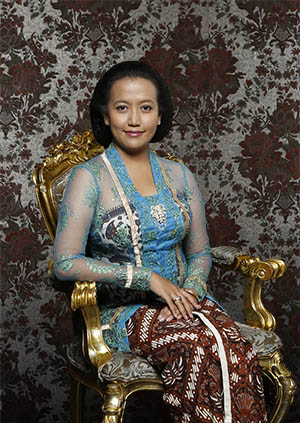
A kebaya is an upper garment traditionally worn by women in Southeast Asia, notably in Brunei, Indonesia, Malaysia, Singapore, and Southern Thailand. It is also worn in parts of southern Philippines and Cambodia.
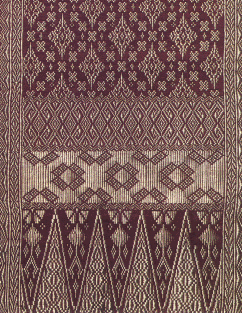
Songket or sungkit is a tenun fabric that belongs to the brocade family of textiles of Brunei, Indonesia, Malaysia, and Singapore. It is hand-woven in silk or cotton, and intricately patterned with gold or silver threads. The metallic threads stand out against the background cloth to create a shimmering effect. In the weaving process the metallic threads are inserted in between the silk or cotton weft (latitudinal) threads in a technique called supplementary weft weaving technique.
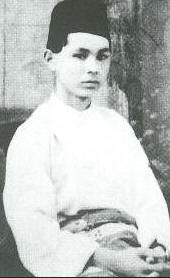
Baju Melayu is a traditional Malay costume for men, originated from the court of Malacca Sultanate and is traditionally worn by men in Brunei, Malaysia, Singapore, parts of Indonesia, southern Philippines, and southern Thailand. In its formal form, Baju Melayu is the national dress of Malaysia and Brunei, typically worn during official events and functions.

The songkok or peci or kopiah is a cap widely worn in Brunei, Indonesia, Malaysia, Singapore, the southern Philippines, and southern Thailand, most commonly among Muslim males. It has the shape of a truncated cone, usually made of black or embroidered felt, cotton or velvet. It is also worn by males in formal occasions such as weddings and funerals or festive occasions such as the Eid ul-Fitr and Eid al-Adha holidays. In Indonesia, the peci is also associated with the nationalist movement.

Pakaian is the term for clothing in Malaysia's national language. It is referring to things to wear such as shirts, pants, shoes etc. Since Malaysia is a multicultural nation: Malay, Chinese, Indian and hundreds of other indigenous groups of Malay Peninsula and Borneo, each has its own traditional and religious articles of clothing all of which are gender-specific and may be adapted to local influences and conditions. Previously, traditional clothes were worn daily. However, by excluding Baju Melayu, Baju Kurung many are now only worn on special occasions such as marriage ceremonies and cultural events.

Blangkon or belangkon is a form of traditional cultural Javan headdress or headgear, made of traditional native Javan cultural clothing textile materials. Originating from the intricate Javanese cultural tradition and philosophy, there are four standard types of Blangkon that are commonly associated to the original ancestral-styles form, distinguished by the pakem and its invention origins, namely Yogyakarta-style, Surakarta-style, Kedu-style, and Banyumas-style. Over time, the Blangkon has also been adopted by another Javan ethnic groups, namely the Betawi, leading to the development of the Jayakarta-style Blangkon, subsequently recognized as Liskol(in Betawi), Belangkon Betawi or Blangkon khas Jakarta(in Indonesian), which characterized by its colorful Batik material, symbolizing the new Javan generations emerged in Sunda Kalapa area.
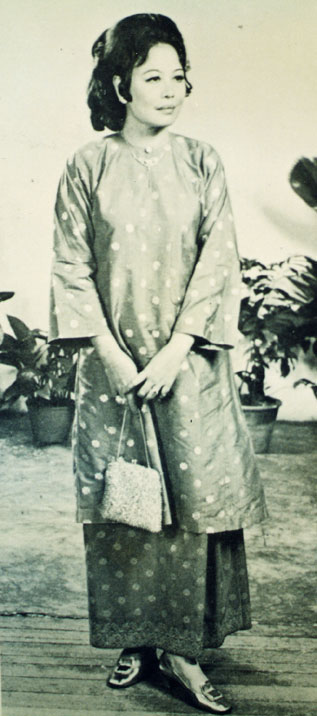
Baju Kurung is a traditional attire of Malays and traditionally worn by women in Brunei, Indonesia, Malaysia, Singapore and southern Thailand. This type of traditional attire is the national dress of Brunei and Malaysia. In Indonesia, this dress is also worn as a regional attire, commonly observed on the island of Sumatra, particularly by the ethnic Malay and Minangkabau women.
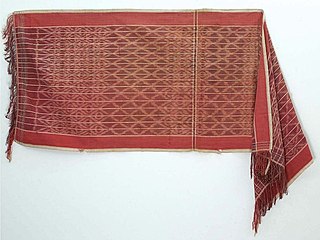
Ulos is the traditional Tenun fabric of the Batak people of North Sumatra in Indonesia. Different kinds of Ulos have different ceremonial significance. The ulos is normally worn draped over the shoulder or shoulders, or in weddings to ceremonially bind the bride and groom together. Ulos are traditionally hand-woven and in the case of higher-quality examples are significant family heirlooms, to be worn at important events, such as funerals and weddings.
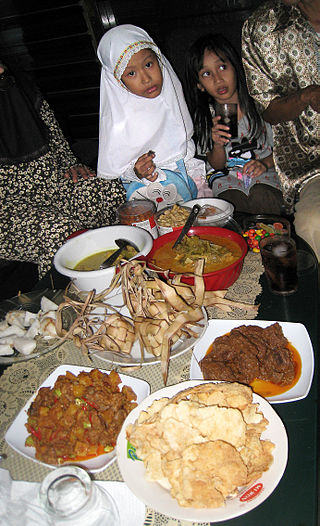
Lebaran is the Indonesian popular name for two Islamic official holidays, Eid al-Fitr and Eid al-Adha in Indonesia, and is one of the major national holidays in the country. Lebaran holiday officially lasts for two days in the Indonesian calendar, although the government usually declares a few days before and after the Lebaran as a bank holiday. Many individuals or families, especially Muslims take paid time off from their workplace during these days.
Obin, real name Josephine Komara, is a textile designer from Indonesia. She is sometimes called a "national treasure" due to her passion for and promotion of traditional Indonesian batik techniques. Her work has achieved worldwide recognition, with fellow Indonesian designers such as Edward Hutabarat and Ghea Panggabean describing her as the real authority and leader of the mid-2000s movement to update and modernise batik. Despite this, Obin describes herself as simply a tukang kain, or vendor of cloth, stating that the genuine artists and designers are the craftsmen who make the textiles retailed through Bin House, her business.

Balinese textiles are reflective of the historical traditions of Bali, Indonesia. Bali has been historically linked to the major courts of Java before the 10th century; and following the defeat of the Majapahit kingdom, many of the Javanese aristocracy fled to Bali and the traditions were continued. Bali therefore may be seen as a repository not only of its own arts but those of Java in the pre-Islamic 15th century. Any attempt to definitively describe Balinese textiles and their use is doomed to be incomplete. The use of textile is a living tradition and so is in constant change. It will also vary from one district to another. For the most part old cloth are not venerated for their age. New is much better. In the tropics cloth rapidly deteriorates and so virtue is generated by replacing them.

It is quite difficult to define Indonesian art, since the country is immensely diverse. The sprawling archipelago nation consists of 17.000 islands. Around 922 of those permanently inhabited, by over 1,300 ethnic groups, which speak more than 700 living languages.
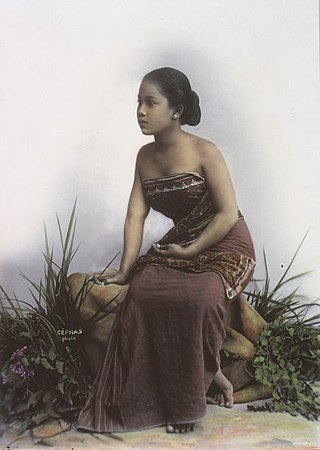
Kemben is an Indonesian female torso wrap historically common in Java, Bali, and other parts of the Indonesian archipelago. It is made by wrapping a piece of kain (clothes), either plain, batik printed, velvet, or any type of fabrics, covering the chest wrapped around the woman's torso.

The bodo blouse, locally known as baju bodo, is a sheer and transparent short-sleeved loose blouse, a traditional attire for women of the Bugis and Makassar peoples of South Sulawesi, Indonesia. A bodo blouse is traditionally combined with a matching woven sarong that covered the waist below the body.
